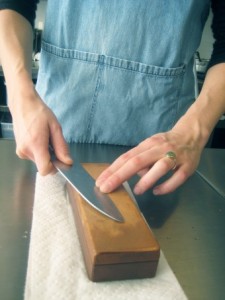 Got a dull knife, sharpen it with a whetstone
Got a dull knife, sharpen it with a whetstone
A dull knife is not only ineffective, but it can also be dangerous. If your knife is dull, you’ll have to use more pressure to cut, increasing the risk of slippage and injury.
There are numerous ways to sharpen a knife, including fancy, high-tech sharpeners, but one of the most reliable–and affordable–is the whetstone.
What is a whetstone
Whetstone is a term for a number of natural or artificial stones that have properties making them ideal for sharpening. Artificial whetstones are composed of components such as ceramic, silicon carbide or aluminium oxide. These stones are usually double-sided with coarse grit on one side and a fine grit on the opposite side.
Natural whetstones, which typically have finer grades and are best used with oil, are often made from the material Novaculite, which is a variety of quartz.
Preparing to sharpen a whetstone.
The first step in knife sharpening is to lubricate your whetstone. You’ll want to either use oil or water for this process, depending on what type of whetstone you have.
Start by placing your whetstone on a paper towel that sits on top of a cutting board. then soak your whetstone in the lubricant of your choice for approximately twenty minutes. If your whetstone has both a fine and coarse side, you’ll want to start sharpening on the coarse side.
Finding the correct angle for sharpening a whetstone
Most knife experts agree that the ideal angle for knife sharpening for a whetstone is 20 degrees. You’ll want to sharpen your knife using smooth motions. Make sure you perform equal strokes on each side. A good rule of thumb is to perform five strokes on each side of your knife and then touch it; you should be able to feel the difference. The motion should be slow and smooth–never jerky–and should resemble the way you would slice a thin piece of meat.
If you have a double-sided whetstone, proceed to the fine side to further sharpen the knife.
Other important tips for sharpening a whetstone
Always sharpen in a direction away from your body, so in case of an accident you don’t get hurt. Also, make sure to use medium pressure; there’s no need to be overly forceful.
Lastly, another great reason to use a whetstone is that it’s something you can do at home, allowing you to avoid the cost of taking your knife to a professional sharpener.




February 6, 2019 at 11:45 am
Hi, so I just ordered my first good knife (the Wusthof Classic 8 inch) and I was wondering about sharpening, so far I’ve only had my parents horrible horrible dull knives to work with, so I always wanted nice knives after trying them out multiple times and envying my friends. I plan on also getting a tojiro dp santoku, and more nicer stuff down the road, so I know a whetstone is the most ideal thing.